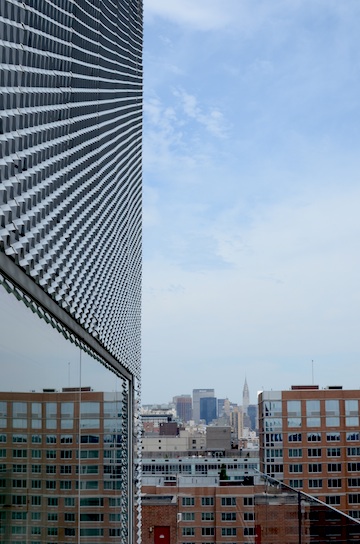
View of the city from the top of the New Museum, 2011, Amy Bernstein
The summer in the country's art capital is vibrant with some of the best shows of the year, despite being the typically slow season. If you happen to be heading to the other coast, these are some of the most riveting shows in the city at the moment. The general atmosphere of current exhibitions is riding a wave of excitement that feels as if it has a tentative momentum. However, if you plan to stay here in the lovely paradise of our summer, I hope this is in the very least, inspiring; I know seeing this work was for me.
The Guggenheim.
Lee Ufan.
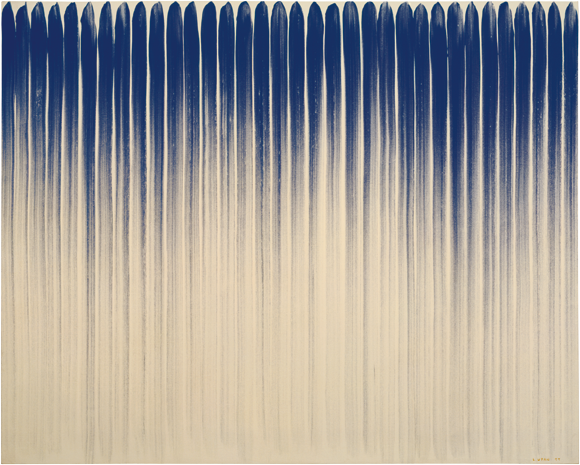
"From Line", Mineral Pigment and Glue on Canvas, 1977, Lee Ufan
The Korean born artist's retrospective at the Guggenheim is an eloquent tour de force. Frank Lloyd Wright's design of the museum accentuates Ufan's transcendental intentions not only visually but also physically: as the viewer walks chronologically through the retrospective you coincidentally ascend the spiral shape of the building and thus move closer to the sky, the building's main light source. Ufan's work is a lifetime of visual symbols hinting at the intention of a life. The work
is full even as it is empty, and the symbols he creates make known the movement and breath of their maker. The exhibition is successful in that the artist's philosophies are naked and brave in the work. Nothing is hidden or convoluted. Ufan's is work to aspire to. (on view through September 28)
The Met.
Alexander McQueen Savage Beauty. Dark and inquisitive, this extravagant exhibition is a fantasy unto fantasy. The post-humous retrospective of one of the fashion world's most promising prodigies is riddled with the pathos of his suicide; in viewing such brilliance, one can never help but wonder what might have been with a lifetime of such inventive fervor. McQueen's investigations, while often taking cues from the formal traditions of Japan and endlessly drawing and imitating the natural world, are bound (literally) to and by the United Kingdom; each collection hearkens to the lyricism of the Victorian fairy tale, despite material or timbre, despite the expressive indulgence of ecstasy or pain. McQueen's morbid fascinations surround not only death but the cold cruelty of murder and violence, as seen through the variety of references to such references as the bloody history of Scotland and to the photographer Joel Peter Witkin. The aesthetics of the gothic and even the goth subculture are laudable in the sophistication with which McQueen indulges in them, and the effects of his subversions are otherworldly. The ideas of dominance and the dominated are ever present, yet in the world of apparel design, these concepts can hedge toward the thin ice zone of exploitation, simply due to the fact that one's expression as an apparel designer fits around the body of a human and usually the body of a human woman. McQueen states that he wishes to empower women through his designs, but truly his designs are solely a sounding board for his own expressive voice. In this voice, he is consistently intent on the material transcending reality through form and sensual story. Geometry is a physics that is not an option. It is rather opulence and the body which will be upended and pushed in order to be reborn. McQueen's oeuvre is beyond the wax and wane of fashion and holds its own in the language of art. Savage Beauty is imaginative toward inspiration. (on view through August 8)
Richard Serra Drawing Retrospective.
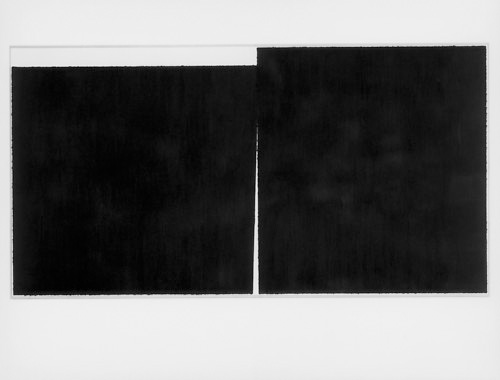
"The United States Government Destroys Art", Painstick on Paper, 1989, Richard Serra
Serra's enormous drawings sit heavy on the walls of the museum, humming big bass notes, almost inaudible vibrations their timbre sits so low. This is one of the simplest, yet spatially most subversive of exhibitions. Characteristically physical, Serra's black squares falter our sense of known space and can render you physically off balance. There is an inherent temptation to try and touch a few of the corners of the bigger works that seem to jump off of the surface of the canvas. Simple black oil stick and graphite are basic materials that render these powerful visual subversions. This simplicity is a reckoning; the intrinsic power of geometry and composition are starkly refreshing set against the opulence of McQueen. Dimensional illusion is a possibility with the simplest of shapes despite the contemporary eye's gluttonous daily bath of visual technological sophistication. Walking through the labyrinthine design of this drawing retrospective is an act of reconnaissance in eternal visual rule making. (on view through August 28)
The New Museum.
Ostalgie.
This exhibition is spectacular in the sheer breadth of the artists included. In this, the exhibition conveys not only the historical experience of living under the philosophies and realities of fascism, but also how alive its aftermath still is in the psyches of subsequent generations. This exhibition is enormously rich, exhibiting the intellectual, the fantastical, the guerrilla, and the mystical all under one roof. The feeling of this part of the world is as palpable as the reality of such far reaching, oppressive ideologies were rebelled against and embraced with amidst the promises of intellectual, spiritual, and financial freedom. When I saw this exhibit, Norway had been bombed the previous day, and David Ter-Oganyan's piece "This is Not a Bomb"(2006)was installed throughout the museum, in the stairwells and elevators. I first saw the piece as I was jammed up against one of the "non bombs" in the elevator. I did not realize any of the details of the piece's construction (which are completely inane everyday objects upon inspection); the only thing my eye read was bomb. Even in my knowing of being in a designated art space, I was so jarred by the previous day's bombing in another such docile and unexpected environment (Norway), that the moment I saw the piece, I hurriedly exited the elevator on the wrong floor, anxious to get away from the thing as quickly as possible. It seems that we are losing the war on terror. I was terrified, and my instinct was not original but inculcated and nourished. Terrorism is bleeding its fear into the beginning of the edges of normative society, and as much as I will be the intellectual warrior that I must, in that moment, I became a casualty. I am uneasy in the realization of this new fear in me, and Ter-Oganyan's piece catalyzed the recognition of this new part of my self.
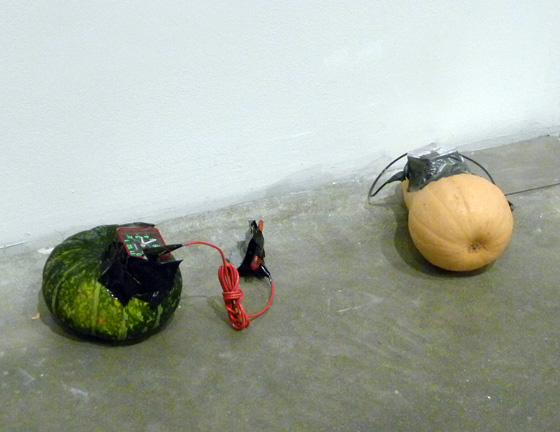
"This is Not a Bomb", 2006, David Ter-Oganyan
Thus broke the rest of the exhibition, as I witnessed artists terrorized and victimized by the politics of their governments. The exhibition is thoroughly rich and heartbreaking, highlighting artists deceased and quite young, from Estonia to Armenia. Many of these artists worked in secret and many were tortured by the inevitable solitude such regimes manifest. I left the exhibition almost in tears, overwhelmed by the inanity of humanity, the senseless cruelty that continues to regenerate and proliferate, and the buoying resilience of idealogies that both sustain and poison us.
(on view through September 25)
Moma PS1.
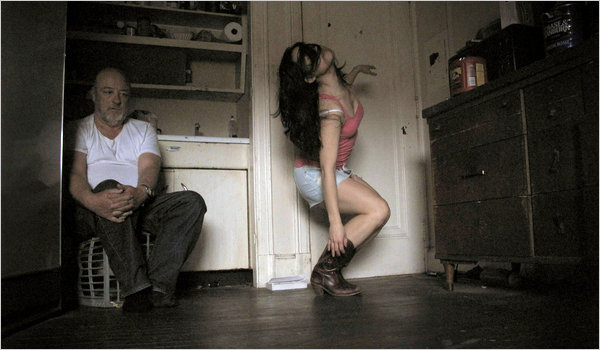 "Exorcism in January", Video, Laurel Nakadate
"Exorcism in January", Video, Laurel Nakadate
Laurel Nakadate. The artist Laurel Nakadate's exhibit, "Only the Lonely" is a turbulent, coming of age viewing experience filled with angst, consternation, and in the end, a possible transcendence. The impetus for the artist's work often seems unclear, and the seemingly entire lack thereof is, at times, incredibly offensive. The simple explanation of narcissism seems far too obtuse for such a venue, yet is the most blatant first impression of her self portraits, which feature her image captured over the span of a year, weeping in different locales and often mostly naked. The central gallery exhibits these days of supposed “sadness” which seem more like technically bad (but still cool and definitely en low-fi vogue) American Apparel advertisements. Yes, this artist looks great naked, and the locations of her shoots, though often repeating, offer up something of a guessing game for a narrative, which seems slightly redeeming. Her beautiful body is nubile and athletic and desirable, and thus we want to look at her. Yet, the emotional manipulation of her tear stained face and her naked body seem like below-the-belt cheap shots (literally) that leave you wanting more than a one liner. Towards the end of the procession of giant photos, there are a couple of images where the artist seemed to be masturbating; at the moment I thought this a much more honest account of her intentions.
However, as one continues through the galleries to experience her video work, it seems that while she wants to be somehow commenting on the male gaze, she seems only to be enslaved and obsessed by it. Her utilization of this gaze as a means to exploit her own subjects seems not savvy but cruel, and is exceptionally one dimensional. In the piece, "Lessons 1-10", in which she agrees to become an artist's figure model in exchange for video footage is almost hilarious; the gentleman artist seems entirely disinterested in her as a sexual object, and his drawings reveal this. The harder she tries to be desirable, the more cartoonish his drawings become. At one point she delicately feeds him oranges, and he eats them.
More than exploiting anyone or an idea at all, this artist seems to still be exploiting her own imprisonment of this phenomena. Perhaps this is where the power of her work lies: in the witnessing of this woman's inability to escape such a societal imposition even under the umbrella of a critical forum. In this progression of thoughts, I suddenly become the compassionate viewer, because she seems unknowing in this. While there is a compelling earnestness in the situational trials she documents, the work is unrealized as something more than searching. (on view until August 8)

"Any Ever", Video, 2007-10, Ryan Trecartin and Lizzie Fitch,
Oh my, the Trecartin and Fitch team have pushed the limits even farther this time with "Any Ever". Their realities change as we grow up, and now their focus changes (although not entirely) from the excavation and exploitation of interpersonal relationships to the mental infiltration of the corporate world. This team's budget has gotten exponentially higher, which at first was slightly off putting; the unmediated use of CGI throughout the digital world is a little numbing: all right, we get it, recreating the third dimension on a flat surface is really effing cool. Isn't that what painting has been telling us for like a million years? Yet, knowing the level of sophistication and consideration behind this work, the CGI is repurposed indeed because of its numbing qualities.
The entirety of the "Any Ever" experience is amplified into the third dimension as Fitch has constructed the strangest of theaters in which to sit whilst viewing the films. These Ikea filched, glamour bomb (handcuffs often attach the headphones to whatever piece of furniture you are seated) corporate hip hop party rooms extend the films into your physical space. Now, they touch you. Everything included is disposable and essential, much like our cultural material obssessions.
Trecartin is one of the most challenging and boundary breaking contemporary poets of our time. I sense a method to his lyrical madness that I cannot quite place, like a random algorithm or a patterned mad lib. The expected article of speech in many of his phrases consistently trumps your ear with something unfamiliar, the pattern of which I have not quite determined. This is much less jarring when he is performing (he is simply the best performer of his own monologues) as opposed to the other actors. Perhaps it is only the cadence of the script that has such a pronounced rhythm, yet there is an audible pattern to Trecartin's seeming freeplay. These films are amazing; they are us, recognizable and ridiculously funny in their poignant highlighting of our absurd preoccupations. They are the mimicry of our frenetic consciousness. (on view through September 3)
Chelsea.
To summarize this vibrant gallery district is always a challenge as it encompasses such a vast breadth of missions and ideologies. The summer, particularly August, in New York is a month for slowing down a bit, yet this never insinuates that the picture of the city and its zeitgeists are any less discernible. This season is alive, more easy breezy but also trying. Chelsea abounds with painting this summer; abstraction is a viable language again, and it is very interesting to see. Painters are searching for forms of subversion and language which often entails using other media besides paint and calling it painting. This is something that has been happening for a while and is interesting for a second, yet it cannot be the thing. And thus they keep searching. Sol Lewitt will make me a religious woman. His mystical selflessness is like drinking cool river water in a candy store.
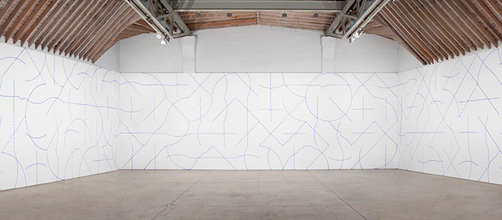
"Drawing #122", 1972, Sol Lewitt
Chelsea in its entirety is so often such a failing human account of an attempt at greatness that it is often hard to take, and yet we have to keep looking, because it is trying and it is failing and one day it probably won't.
























 "Exorcism in January", Video, Laurel Nakadate
"Exorcism in January", Video, Laurel Nakadate
